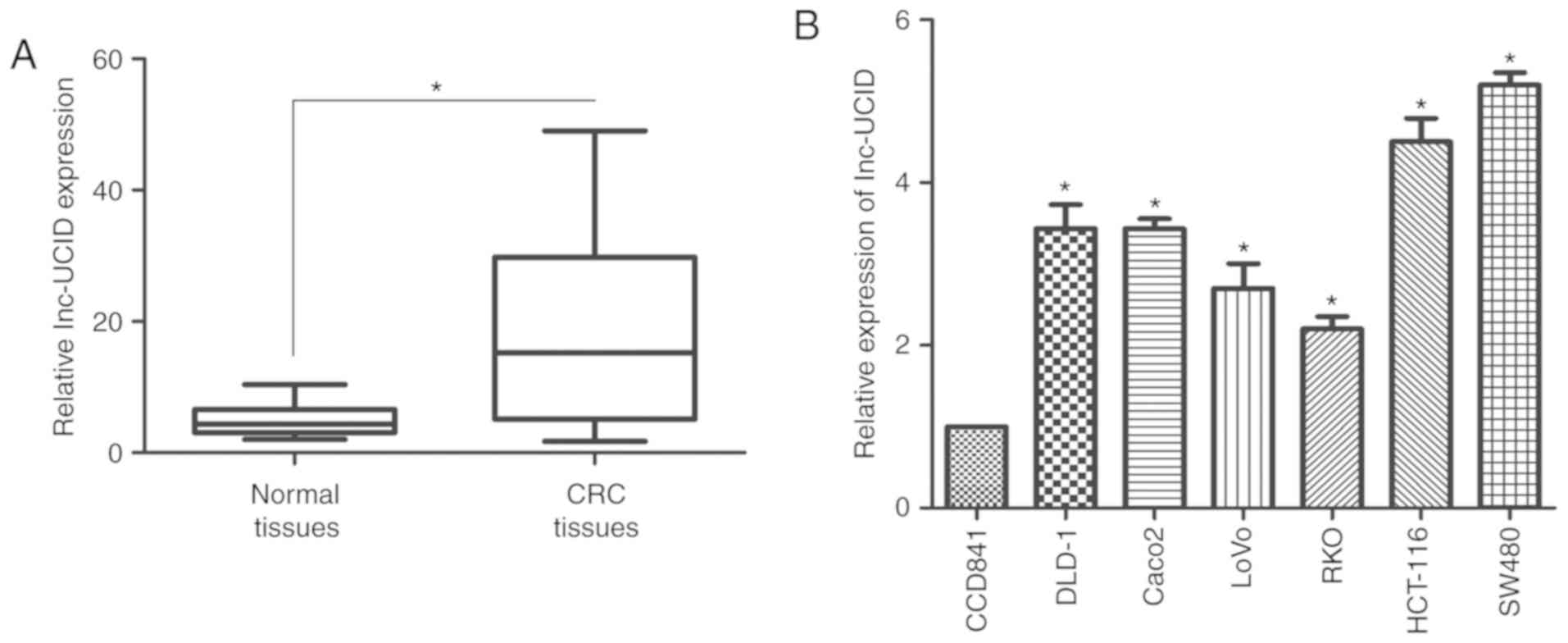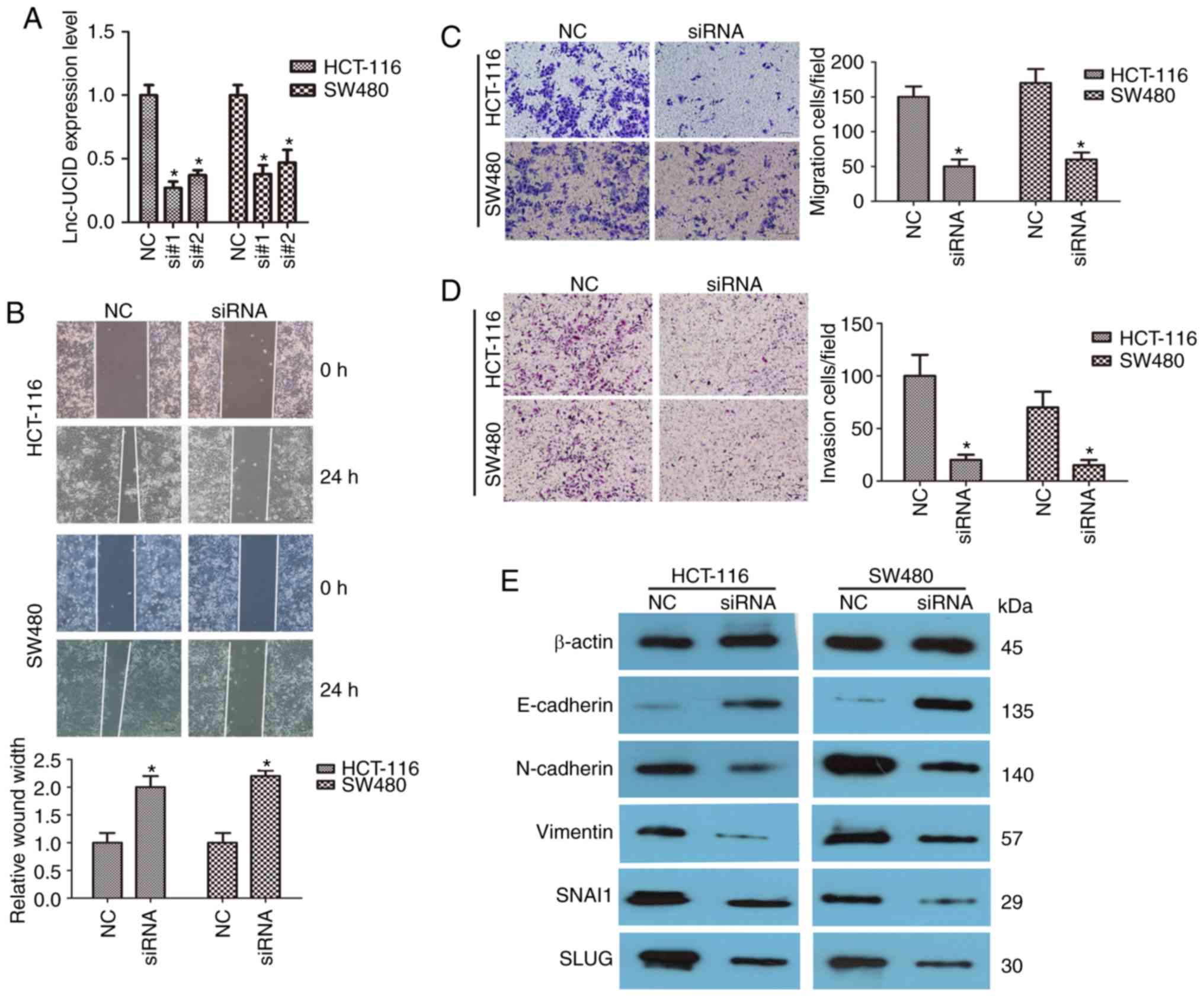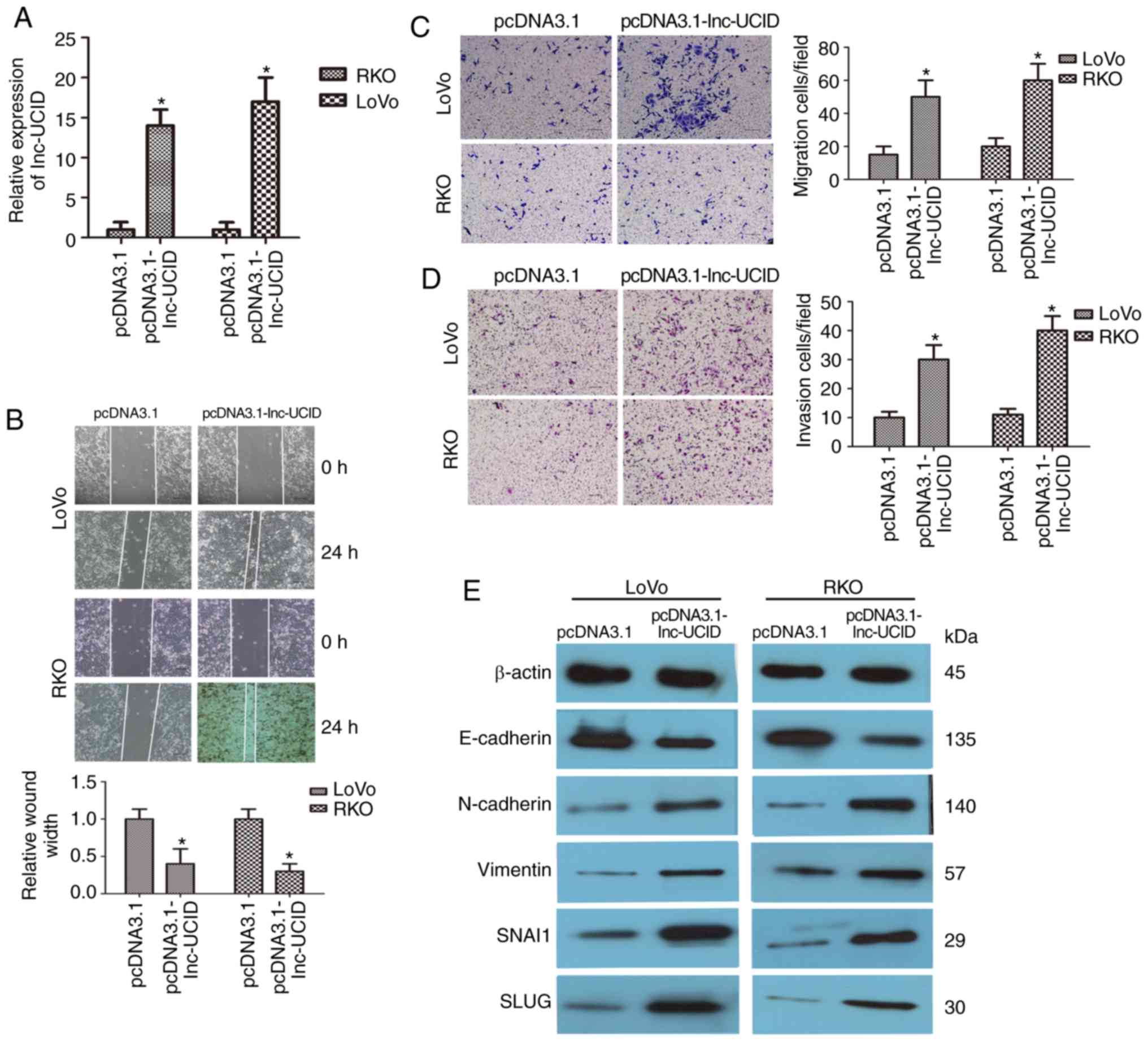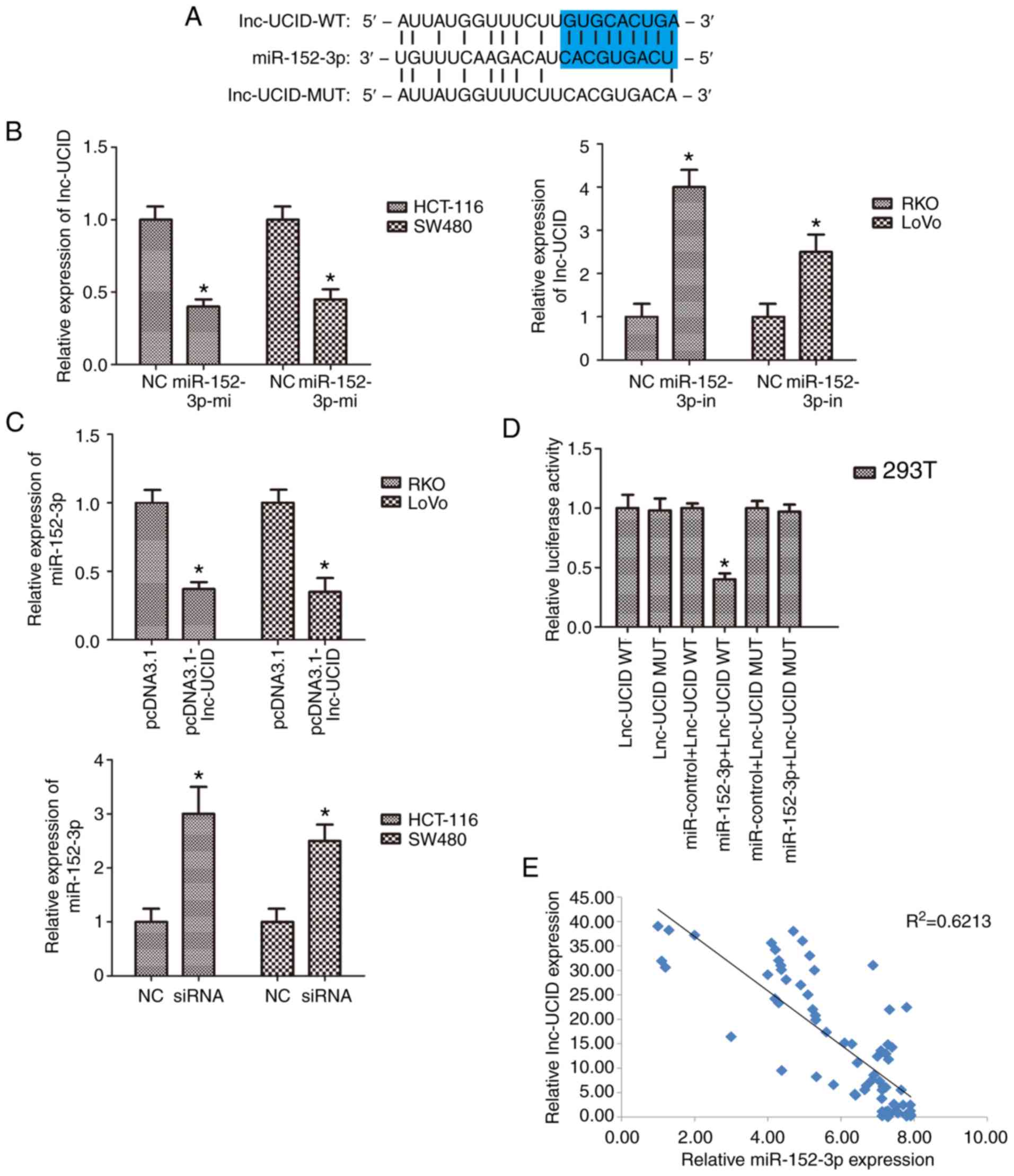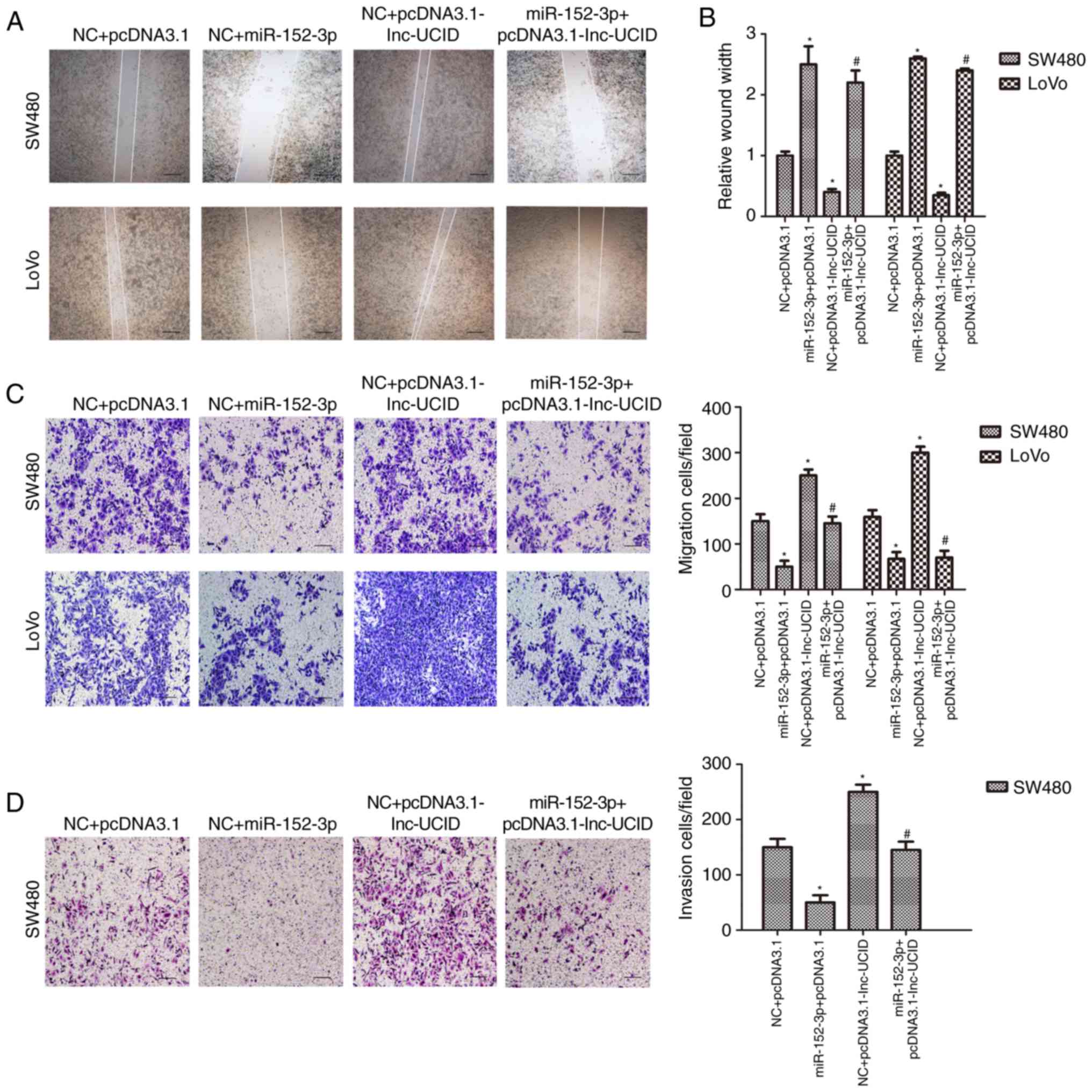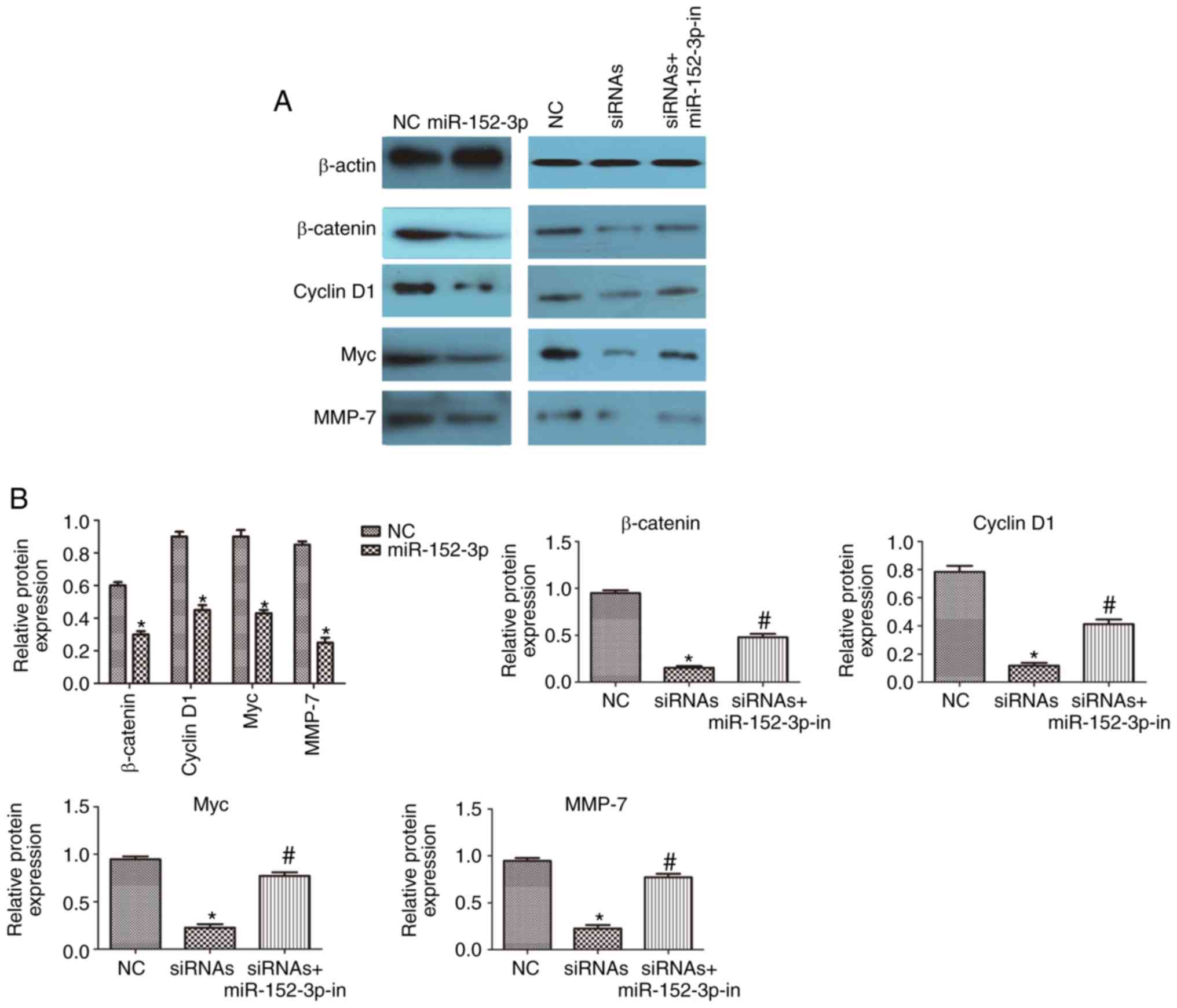Long noncoding RNA UCID sponges miR‑152‑3p to promote colorectal cancer cell migration and invasion via the Wnt/β‑catenin signaling pathway
Retraction in: /10.3892/or.2023.8529
- Authors:
- Published online on: July 6, 2020 https://doi.org/10.3892/or.2020.7670
- Pages: 1194-1205
Abstract
Introduction
Colorectal cancer (CRC) affects more than 1.2 million individuals per year, making it the world's fourth most deadly cancer (1–3). While scientific and clinical advances have uncovered promising new treatment options, the five-year survival rate for metastatic CRC is still low, at approximately 14% (4). The potential mechanisms of CRC have been studied in depth, as evidenced by research in genetic modification, diet, environmental impact, and lifestyle (5). However, to develop more effective CRC therapeutic targets, a more detailed understanding of the molecular mechanisms of CRC is required.
In recent years, accumulating studies have provided evidence to support a close relationship between dysregulation of long noncoding RNAs (lncRNAs) and carcinogenesis, tumor metastasis, and therapeutic drug resistance (6). lncRNAs are more than 200 bp long, single-stranded and have no or low protein coding capacity. lncRNAs are critical regulators of various human biological processes, including cancer (7). Abnormal expression and dysfunction of lncRNAs have been identified as key factors in the control of the development and progression of many types of cancer, including CRC (8,9). The development of high-throughput sequencing and the elucidation of their key biological roles in CRC progression have increased research into lncRNAs as novel CRC biomarkers for therapy, prognosis prediction, and early diagnosis.
lncRNAs frequently act as either oncogenes or tumor suppressors in human cancer; they are key regulators of cancer development and progression and can also be used as diagnostic and prognostic markers (10). MicroRNAs (miRNAs) are ~22 nucleotides in length and regulate the expression of target genes by base pairing with the 3′-untranslated region (UTR), 5′-UTR, and/or complementary sites in the coding region (11,12). Research has shown that lncRNAs and miRNAs are implicated in various pathophysiological mechanisms. In particular, lncRNAs can bind miRNAs by acting as competing endogenous RNAs (ceRNAs), thereby regulating the levels of the targeted mRNAs by sponging miRNAs (13). In the present study, we analyzed lncRNA expression in CRC tissues and identified lncRNA UCID (lncRNA upregulating CDK6 by interacting with DHX9), which was previously noted as a potential oncogene in hepatocellular carcinoma (14). However, few studies on the relationship between lnc-UCID and CRC have been reported to date. The results of the present study demonstrated that lnc-UCID was markedly upregulated in CRC tumor tissues. lnc-UCID was found to promote the migration and invasion of CRC cells. These results showed that lnc-UCID may be an oncogenic lncRNA in CRC. In addition, lnc-UCID binds miR-152-3p directly, which negatively regulates the miRNA's functions. Thus, we believe that lnc-UCID functions as a ‘molecular sponge’ for miR-152-3p, further regulating the expression levels of its downstream target mRNAs. In summary, lnc-UCID may promote the occurrence and development of CRC by regulating CRC cell migration and invasion.
Materials and methods
Patients and CRC tissue samples
The Affiliated Hospital of Qingdao University provided 75 samples of CRC tissues from 38 female and 37 male patients and their corresponding adjacent non-tumor tissues (sampled at more than 5 cm from the tumor) from May 2018 to May 2019. For each subject, the pathological stage of the postsurgical specimen was determined using the 7th edition of the International Union for Cancer Control (UICC) CRC Tumor Lymph Node Transfer (TNM) staging system (15,16). Written consent of all patients and approval by the Hospital Ethics Review Board were obtained before use of the clinical materials. The specimens were stored in liquid nitrogen until use.
Cell lines and their culture conditions
The Institute of Biochemistry and Cell Biology of the Chinese Academy of Sciences (Shanghai, China) provided five human CRC cell lines (HCT-116, DLD1, RKO, LoVo and SW480) and a normal colon cell line (CCD841). The cells were grown in Roswell Park Memorial Institute (RPMI)-1640 medium with 10% fetal bovine serum (FBS) (Gibco; Thermo Fisher Scientific, Inc.), 100 U/ml penicillin, and 100 mg/ml streptomycin (Gibco; Thermo Fisher Scientific, Inc.) at 37°C in a 5% CO2 atmosphere.
RNA extraction and quantitative real-time reverse transcription polymerase chain reaction (qRT-PCR)
Total RNA was extracted from cells and tissues using TRIzol reagent (Invitrogen; Thermo Fisher Scientific, Inc.). RNA was converted into cDNA using reverse transcriptase according to the manufacturer's instructions (Takara). Quantitative real-time PCR was used to determine the relative expression level of lnc-UCID using a SYBR Green PCR Master Mix Kit (Takara). The qPCR was carried out on a Bio-Rad Real-Time PCR instrument (Bio-Rad Laboratories, Inc.). The expression of the miRNA was determined using a SYBR PrimeScript™ miRNA RT PCR Kit (Takara). Table 1 shows the primer sequences used. The ΔΔCq method was used to analyze the data (17).
Bioinformatics analysis DIANA-LncBase Predicted v.2 (http://diana.imis.athena-innovation.gr/DianaTools/index.php? r=lncBase/index) and TargetScan 7.2 (http://www.targetscan.org/) were used to predict the putative target genes for lnc-UCID and miR-152-3p.
Short interfering RNA (siRNA) and miRNA transfection
Table I also shows the sequences of the siRNAs that target lnc-UCID (si#1 and si#2; GenePharma, Shanghai, China). Lipofectamine 3000 Transfection Reagent (Thermo Fisher Scientific, Inc.) was used in the cell transfection procedures. The miRNA mimic and its negative control mimic (NC) and the miRNA inhibitor and its negative control inhibitor were obtained from GenePharma. Table I shows the sequences of the transfected RNAs.
Plasmid construction and cell transfection
The SuperScript III First-Strand Synthesis System (Thermo Fisher Scientific, Inc.) was used to produce the cDNA template for RT-qPCR using gene-specific primers for lnc-UCID. The lnc-UCID sequence was amplified using Platinum Taq DNA Polymerase, High Fidelity (Thermo Fisher Scientific, Inc.). The full-length lnc-UCID cDNA was cloned into the expression vector pcDNA3.1(+) (Thermo Fisher Scientific, Inc.). NIH 3T3 genomic DNA was used to amplify the lnc-UCID miRNA target sequence, which was then cloned into the plasmid pmiR-RB-REPORT™ (lnc-UCID-WT; RiboBio). The negative control was the plasmid containing a mutated target sequence (lnc-UCID-MUT; RiboBio). The plasmid luciferase activities were assessed using a Dual-Luciferase Reporter Assay system (Promega Corp.).
Wound-healing assay
Cells (LoVo, RKO, HCT-116 and SW480) were placed in plates after transfection with pcDNA3.1-lnc-UCID and si-lnc-UCID at 2×105 cells/well and incubated for 48 h. Wounds were made in the cell monolayer by making a scratch with a pipette tip. The cells were then incubated in serum-free medium at 37°C for 24 h. The scratches in the cell monolayers were imaged with an inverted microscope (Nikon; magnification, ×100) at 0 and 24 h.
Transwell assay
Cells were transfected with pcDNA3.1-lnc-UCID and si-lnc-UCID for 48 h before being suspended in serum-free medium. Briefly, 8×104 CRC cells (LoVo, RKO, HCT-116 and SW480) suspended in 200 µl serum free medium were seeded into the upper chamber with a porous membrane of Transwell inserts coated with Matrigel (BD Bioscience) for the Transwell invasion assay or without Matrigel for the migration assay. Medium containing 10% serum was placed into the bottom chamber to attract the cells. After incubation at 37°C for 24 or 48 h, the numbers of invaded or migrated cells were stained and counted under an inverted microscope (Nikon, Tokyo, Japan; magnification, ×100).
Western blotting
Proteins were extracted from cells and tissues using radioimmunoprecipitation assay (RIPA) buffer (Thermo Fisher Scientific, Inc.) supplemented with a protease inhibitor cocktail (Roche Applied Science). Protein samples (40 µg/sample) in the lysates were separated using 10% sodium dodecyl sulfate-polyacrylamide gel electrophoresis and were then transferred to polyvinylidene fluoride membranes (Millipore). The membranes were blocked with skimmed milk before being incubated overnight at 4°C with antibodies recognizing E-cadherin (cat. no. 14472), N-cadherin (cat. no. 13116), vimentin (cat. no. 5741), β-catenin (cat. no. 8480), transcription factor 4 (TCF4, cat. no. 2569T), Myc (cat. no. 2276), matrix metalloproteinase-7 (MMP-7; cat. no. 3801), Snail family transcriptional repressor 1 (SNAI1; cat. no. 3879), Snail family transcriptional repressor 2 (SLUG; cat. no. 9585), and β-actin (cat. no. 4970) (all from Cell Signaling Technology, Inc.). The membranes were then incubated with HRP-linked secondary antibodies (cat. nos. 7074 and 7076, Cell Signaling Technology, Inc.) for 1 h at room temperature. An enhanced chemiluminescence kit (Millipore) was used to detect the immunoreactive proteins on the blots. Protein quantification was analyzed by Quantity One software version 4.6.2 (Bio-Rad Laboratories, Inc.) and the intensity values were normalized to β-actin.
Immunofluorescence
Cells were plated into 24-well culture plates at 1.0×104 cells/well and then transfected with pcDNA3.1-lnc-UCID and si-lnc-UCID to overexpress or knock down lnc-UCID expression, respectively. Anti-E-cadherin (cat. no. 14472) and anti-N-cadherin (cat. no. 13116) (dilution 1:100; Cell Signaling Technology, Inc.) antibodies were added to the cells in the plates and incubated at 4°C overnight. Then, Texas Red-conjugated anti-rabbit antibodies (cat. no. A-21428; dilution 1:200; Life Technologies, Inc.) were incubated with coverslipped cells for 30 min at room temperature and then stained with 2-(4-amidinophenyl)-1H-indole-6-carboxamidine (DAPI) (10 mg/ml; Promega Corp.). The coverslipped cells were imaged via fluorescence microscopy (FV1000; Olympus). Images were captured using a confocal microscope (magnification, ×400).
Statistical analysis
The experiments were performed at least six times, and the data are expressed as mean ± standard deviation (SD). Comparisons between groups were analyzed using a Student's test and multiple group comparisons were analyzed using one-way ANOVA with Tukey's post hoc test. The correlations between lnc-UCID and CRC clinical characteristics were determined using Pearson's Chi-squared test. All statistical analyses were performed using SPSS 22.0 (IBM Corp.). P<0.05 was indicative of a significant difference.
Results
lnc-UCID is overexpressed in CRC samples
RT-qPCR was used to assess the GAPDH-normalized expression level of lnc-UCID in 75 paired CRC samples and their histologically normal adjacent tissues. Compared with its level in the normal tissues, lnc-UCID levels were significantly upregulated in the CRC samples (P<0.01; Fig. 1A). Correlation analysis between lnc-UCID expression and the clinicopathological features revealed that overexpression of lnc-UCID was correlated with N stage (Table II). There were no correlations between lnc-UCID expression and patient age, sex, tumor size, tumor histology grade, or T stage (Table II). Thus, lnc-UCID expression may be useful to develop new markers for CRC progression and prognosis. Next, RT-qPCR was used to determine the expression levels of lnc-UCID in CRC cell lines (SW480, HCT-116, Caco-2, DLD-1, LoVo, and RKO) and the normal colon cell line (CCD841), to investigate the potential biological function of lnc-UCID in CRC progression. Significantly higher lnc-UCID expression was detected in all CRC cells compared with that in the CCD841 cells (P<0.05; n=6; Fig. 1B). Taken together, the results confirm that lnc-UCID is overexpressed in CRC.
Knockdown of lnc-UCID inhibits CRC cell migration and invasion
HCT-116 and SW480 cells were transfected with two different siRNAs to knock down lnc-UCID (designated si#1 and si#2) to assess the possible role of lnc-UCID in CRC. Both siRNAs efficiently knocked down endogenous lnc-UCID expression (P<0.05; n=6; Fig. 2A). Next, wound-healing assays were used to examine the role of lnc-UCID in CRC cells. Compared with that of the control group, HCT-116 and SW480 cells transfected with si-lnc-UCID (siRNA) showed significantly slower migration into the wound space when compared with the negative control (NC) group (P<0.05; n=6; Fig. 2B). Transwell assays showed that lnc-UCID knockdown significantly inhibited the migration and invasion capacities of HCT-116 and SW480 cells (P<0.05; n=6; Fig. 2C and D). To gain a deeper understanding of the mechanisms of invasion and migration, the levels of several important epithelial-mesenchymal transition (EMT) proteins were detected following lnc-UCID knockdown. The expression levels of N-cadherin, vimentin, SNAI1, and SLUG were significantly decreased after lnc-UCID knockdown, whereas that of E-cadherin was significantly increased (P<0.05; n=6; Figs. 2E and S1). Furthermore, immunofluorescence assay was used to detect the expression levels of E-cadherin and N-cadherin. After knockdown of lnc-UCID in SW480 cells, E-cadherin expression was increased, whereas that of N-cadherin was decreased (Fig. S2). Collectively, our results suggest that lnc-UCID promotes cell migration and invasion in CRC.
Overexpression of lnc-UCID promotes CRC cell migration and invasion
Next, the effects of lnc-UCID overexpression by transfection of pcDNA3.1-lnc-UCID in CRC cells were explored. We focused on LoVo and RKO cells, both of which have low endogenous lnc-UCID levels. After transfection with the pcDNA3.1-lnc-UCID vector, lnc-UCID expression was significantly increased in both the LoVo and RKO cell lines compared with that in cells transfected with the empty pcDNA3.1 vector (P<0.05; n=6; Fig. 3A). Wound-healing assays also showed promotion of cell migration in both cell lines after lnc-UCID overexpression (P<0.05; n=6; Fig. 3B). Transwell assays also showed that lnc-UCID increased the migration and invasion capabilities compared with those in the control cells (P<0.05; n=6; Fig. 3C and D). The levels of several important EMT proteins were then detected in the lnc-UCID-overexpressing CRC cells. lnc-UCID overexpression led to the increased expression levels of vimentin, N-cadherin, SLUG, and SNAI1 and decreased E-cadherin expression (P<0.05; n=6; Figs. 3E and S3). Furthermore, an immunofluorescence assay showed that lnc-UCID upregulation decreased the levels of E-cadherin and increased the levels of N-cadherin in LoVo cells (Fig. S4). These results suggest that lnc-UCID promotes EMT progression in CRC cells.
lnc-UCID directly binds miR-152-3p
To further examine the mechanism by which lnc-UCID contributes to the CRC malignant phenotypes, the DIANA-LncBase Predicted v.2 tool and the TargetScan database were used to search for potential targets of lnc-UCID, which identified a tumor-suppressive microRNA, miR-152-3p. The putative binding site of miR-152-3p within lnc-UCID was located at region 407–428 (Fig. 4A). SW480 and LoVo cell lines were transfected with miR-152-3p mimic and inhibitor to assess the expression levels of miR-152-3p. The mimic and inhibitor efficiently upregulated and knocked down miR-152-3p expression, respectively (P<0.05; n=6; Fig. S5). Increased miR-152-3p expression using its mimic reduced lnc-UCID levels (P<0.05; n=6; Fig. 4B). In contrast, antagonism of miR-152-3p increased lnc-UCID levels (P<0.05; n=6; Fig. 4B). Importantly, overexpression or knockdown of lnc-UCID also reduced or increased the expression levels of miR-152-3p (P<0.05; n=6; Fig. 4C). To confirm that miR-152-3p binds lnc-UCID, wild-type (lnc-UCID-WT) and mutant type (lnc-UCID-mut) miR-152-3p binding sites were constructed in lnc-UCID luciferase reporters. The results showed that expression of miR-152-3p was significantly attenuated the luciferase activity of the lnc-UCID-WT reporter, but not that of the lnc-UCID-MUT reporter (P<0.05; n=6; Fig. 4D). Furthermore, in CRC tissues, miR-152-3p expression was frequently downregulated and was negatively correlated with lnc-UCID expression levels (P<0.01, R2=0.6213; Fig. 4E). Taken together, our results indicate that lnc-UCID acts as an miRNA sponge for miR-152-3p.
lnc-UCID suppresses the function of miR-152-3p
We transfected CRC cell lines with the miR-152-3p mimic and the lnc-UCID expression vector to detect whether lnc-UCID mediates the effect of miR-152-3p on cell invasion and migration. In wound-healing assays, miR-152-3p overexpression inhibited cell migration, whereas lnc-UCID promoted cell migration (P<0.05; n=6; Fig. 5A and B). Cotransfection experiments with the lnc-UCID expression plasmid and the miR-152-3p mimic showed that miR-152-3p abrogated lnc-UCID-mediated cell migration (P<0.05; n=6; Fig. 5A and B). Meanwhile, Transwell assays showed that lnc-UCID promoted, and miR-152-3p inhibited CRC migration and invasion (P<0.05; n=6; Fig. 5C and D). Cotransfection with the lnc-UCID expression vector and the miR-152-3p mimic demonstrated that miR-152-3p abrogated the increased cell migration and invasion induced by lnc-UCID (P<0.05; n=6; Fig. 5C and D). Thus, the results showed that lnc-UCID-mediated cell migration and invasion could be decreased by miR-152-3p transfection.
lnc-UCID regulates the miR-152-3p targets within the Wnt/β-catenin signaling pathway
miR-152-3p targets and represses the expression of Wnt1 and β-catenin (18); therefore, we assessed whether Wnt signaling is regulated by lnc-UCID in CRC. Western blotting showed decreased levels of β-catenin in cells overexpressing miR-152-3p compared with those in the NC cells (P<0.05; n=6; Fig. 6A and B). In addition, the levels of the downstream targets Myc, cyclin D1, and MMP-7 were decreased in the cells overexpressing miR-152-3p (P<0.05; n=6; Fig. 6A and B). CRC cells were then transfected with lnc-UCID-siRNAs, with or without an miR-152-3p inhibitor. Knockdown of lnc-UCID decreased the levels of the miR-152-3p targets. In contrast, miR-152-3p inhibition partly abolished the silencing effect of lnc-UCID knockdown on the miR-152-3p targets (P<0.05; n=6; Fig. 6A and B). Meanwhile, lnc-UCID upregulation resulted in increased levels of the miR-152-3p targets (P<0.05; n=6; Fig. 6C and D). Next, the lnc-UCID expression plasmid and the miR-152-3p mimic were cotransfected into CRC cells, and the levels of the miR-152-3p targets were detected. The results showed that the expression of the miR-152-3p targets was partly restored by cotransfection of the miR-152-3p mimic and the lnc-UCID expression plasmid compared with that in the cells transfected with the miR-152-3p mimic alone (P<0.05; n=6; Fig. 6C and D). These results indicate that lnc-UCID regulates the levels of the miR-152-3p targets by sponging endogenous miR-152-3p.
Discussion
Recent studies have shown that long noncoding RNAs (lncRNAs) play key roles in various types of cancer, including the promotion of proliferation and invasion of cancer cells or by acting as oncogenes (19–21). These findings highlight the urgent need for novel therapeutic target discovery to enhance the diagnosis and treatment of colorectal cancer (CRC) patients. lncRNA-based regulatory networks play crucial roles in epigenetic regulation, transcriptional control, and post-transcriptional regulation (22). Hence, the present study aimed to investigate the role of lnc-UCID in CRC. Our findings identified that lnc-UCID binds to miR-152-3p to induce cell migration and invasion in CRC by activating Wnt/β-catenin signaling, providing a novel insight into the molecular mechanism by which lnc-UCID influences CRC progression.
The present study demonstrated that lnc-UCID was markedly overexpressed in CRC tissues compared with that in adjacent nontumor tissues. In addition, the N stages correlated positively with the expression level of lnc-UCID. These results suggest that lnc-UCID might be a potential diagnostic biomarker or therapeutic target in CRC (23–25). Moreover, a previous study reported a 5-year survival rate of higher than 40% in patients with resectable colorectal liver metastases; however, for patients with unresectable colorectal liver metastases, the 5-year survival was <10% (24). Many patients with advanced-stage CRC succumb to the disease due to distant metastasis rather than the primary tumor. Recurrence and metastasis after tumor resection have always been important issues in tumor prognosis and treatment (26–28). Thus, understanding the molecular mechanism of the involvement of lnc-UCID in metastasis may lead to novel effective therapies against CRC. Hence, the potential role of lnc-UCID in CRC was studied by detecting the biological behavior of CRC cells. In this study, functional experiments further revealed that lnc-UCID overexpression enhanced the migration and invasion of CRC cells, whereas lnc-UCID knockdown had the opposite effects, indicating the oncogenic role of lnc-UCID in CRC cells. The initiation of the multistep metastatic process involves misactivation of epithelial-mesenchyme transition (EMT). During EMT, epithelial marker E-cadherin downregulation induces the expression of mesenchymal markers N-cadherin and vimentin (28,29). Therefore, we further investigated the expression of E-cadherin and N-cadherin in CRC cells by western blot analysis and immunofluorescence. Consistently, our results showed that knockdown of lnc-UCID decreased the expression levels of mesenchymal markers and significantly increased the expression levels of epithelial markers, whereas upregulation of lnc-UCID resulted in an opposite effect. These results demonstrated that lnc-UCID promotes EMT progression in CRC cells.
Recent studies have demonstrated that lncRNAs can function as sponges by binding specific miRNAs, thereby downregulating the levels of related miRNAs (30,31). Bioinformatic analyses and dual-luciferase assays showed that miR-152-3p is a direct target of lnc-UCID. Moreover, our study showed that there was a negative correlation between lnc-UCID and miR-152-3p levels in CRC tissues and CRC cell lines. Thus, the effects of lnc-UCID on CRC cell invasion and migration could be partially explained by its function as a ceRNA that sponges miR-152-3p, which represents a possible mechanism by which lnc-UCID functions as an oncogene in CRC.
Abnormally activated Wnt/β-catenin signaling regulates a variety of biological processes in cancer cells, such as proliferation, differentiation, migration, and survival (32). miR-152-3p, a novel tumor-suppressive miRNA, directly binds to key molecules of the Wnt signaling pathway to affect the development and progression of malignant tumors (18,33). The results presented here showed that in CRC, miR-152-3p regulates β-catenin expression. This finding agrees with the results of a previous report in which miR-152-3p induced CTNNB1 (encoding β-catenin) mRNA degradation (18). Based on our results, we hypothesized that miR-152-3p acts as a tumor suppressor to inhibit the migration and invasion of CRC. In addition, lnc-UCID regulates β-catenin expression by sponging endogenous miR-152-3p. lnc-UCID expression also affected the levels of downstream targets, such as cyclin D1, MMP-7, and Myc, whose expression changes were correlated with migration and invasion. Thus, we believe that lnc-UCID binds miR-152-3p to act as an endogenous sponge that abolishes miR-152-3p-induced downregulation of β-catenin expression.
In conclusion, the present study demonstrated that CRC tissue and cell lines overexpress lnc-UCID. The results suggest that the mechanism of the effects of lnc-UCID in CRC metastasis rely partly on the regulation of Wnt/β-catenin signaling. In addition, lnc-UCID expression was found to be correlated positively with clinical parameters, including the N stage. Thus, the results of the present study identify lnc-UCID as a novel molecular biomarker and a promising therapeutic target in CRC.
Supplementary Material
Supporting Data
Acknowledgements
Not applicable.
Funding
The present study was supported by the National Natural Science Foundation of China (no. 81800461).
Availability of data and materials
All the datasets generated and analyzed in the present study are included in this published article.
Authors' contributions
LBS, SFZ and TDS conceived the study design. LBS and JJZ designed the experiments and supervised all research. LBS, SFZ and YH carried out the experiments and prepared the draft of the manuscript. LBS, SFZ and TDS analyzed the data. All authors read and approved the manuscript and agree to be accountable for all aspects of the research in ensuring that the accuracy or integrity of any part of the work are appropriately investigated and resolved.
Ethics approval and consent to participate
CRC specimens were obtained following the guidelines approved by the Care Committee of The Affiliated Hospital of Qingdao University (Qingdao, Shandong), and written informed consent was obtained from patients in all cases.
Patient consent for publication
Not applicable.
Competing interests
The authors declare that they have no competing interests.
References
|
Jemal A, Bray F, Center MM, Ferlay J, Ward E and Forman D: Global cancer statistics. CA Cancer J Clin. 61:69–90. 2011. View Article : Google Scholar : PubMed/NCBI | |
|
Karsa LV, Lignini TA, Patnick J, Lambert R and Sauvaget C: The dimensions of the CRC problem. Best Pract Res Clin Gastroenterol. 24:381–396. 2010. View Article : Google Scholar : PubMed/NCBI | |
|
Brody H: Colorectal cancer. Nature. 521:S12015. View Article : Google Scholar : View Article : Google Scholar : PubMed/NCBI | |
|
Lichtenstern CR, Ngu RK, Shalapour S and Karin M: Immunotherapy, inflammation and colorectal cancer. Cells. 9:E6182020. View Article : Google Scholar : PubMed/NCBI | |
|
Lee J, Jeon JY and Meyerhardt JA: Diet and lifestyle in survivors of colorectal cancer. Hematol Oncol Clin North Am. 29:1–27. 2015. View Article : Google Scholar : PubMed/NCBI | |
|
Jäger T, Ocker M, Kiesslich T, Neureiter E and Neureiter D: Thoughts on investigational hedgehog pathway inhibitors for the treatment of cancer. Expert Opin Investig Drugs. 26:133–136. 2017. View Article : Google Scholar : PubMed/NCBI | |
|
Tay Y, Rinn J and Pandolfi PP: The multilayered complexity of ceRNA crosstalk and competition. Nature. 505:344–352. 2014. View Article : Google Scholar : PubMed/NCBI | |
|
Peng WX, Koirala P and Mo YY: LncRNA-mediated regulation of cell signaling in cancer. Oncogene. 36:5661–5667. 2017. View Article : Google Scholar : PubMed/NCBI | |
|
Forrest ME and Khalil AM: Review: Regulation of the cancer epigenome by long non-coding RNAs. Cancer Lett. 407:106–112. 2017. View Article : Google Scholar : PubMed/NCBI | |
|
Kopp F and Mendell JT: Functional classification and experimental dissection of long noncoding RNAs. Cell. 172:393–407. 2018. View Article : Google Scholar : PubMed/NCBI | |
|
Nam JW, Rissland OS, Koppstein D, Abreu-Goodger C, Jan CH, Agarwal V, Yildirim MA, Rodriguez A and Bartel DP: Global analyses of the effect of different cellular contexts on microRNA targeting. Mol Cell. 53:1031–1043. 2014. View Article : Google Scholar : PubMed/NCBI | |
|
Da Sacco L and Masotti A: Recent insights and novel bioinformatics tools to understand the role of microRNAs binding to 5′ untranslated region. Int J Mol Sci. 14:480–495. 2012. View Article : Google Scholar : PubMed/NCBI | |
|
Cesana M, Cacchiarelli D, Legnini I, Santini T, Sthandier O, Chinappi M, Tramontano A and Bozzoni I: A long noncoding RNA controls muscle differentiation by functioning as a competing endogenous RNA. Cell. 147:358–369. 2011. View Article : Google Scholar : PubMed/NCBI | |
|
Wang YL, Liu JY, Yang JE, Yu XM, Chen ZL, Chen YJ, Kuang M, Zhu Y and Zhuang SM: Lnc-UCID Promotes G1/S transition and hepatoma growth by preventing DHX9-mediated CDK6 downregulation. Hepatology. 70:259–275. 2019.PubMed/NCBI | |
|
Sobin LH, Gospodarowicz MK and Wittekind C: TNM classification of malignant tumors, 7th edition. Wiley-Blackwell. (Oxford). 2010. | |
|
Obrocea FL, Sajin M, Marinescu EC and Stoica D: Colorectal cancer and the 7th revision of the TNM staging system: Review of changes and suggestions for uniform pathologic reporting. Rom J Morphol Embryol. 52:537–544. 2011.PubMed/NCBI | |
|
Livak KJ and Schmittgen TD: Analysis of relative gene expression data using real-time quantitative PCR and the 2(-Delta Delta C(T)) method. Methods. 25:402–408. 2001. View Article : Google Scholar : PubMed/NCBI | |
|
Feng M, Zhang T and Ma H: Progesterone ameliorates the endometrial polyp by modulating the signaling pathway of Wnt and β-catenin via regulating the expression of H19 and miR-152. J Cell Biochem. 120:10164–10174. 2019. View Article : Google Scholar : PubMed/NCBI | |
|
Lv SY, Shan TD, Pan XT, Tian ZB, Liu XS, Liu FG, Sun XG, Xue HG, Li XH, Han Y, et al: The lncRNA ZEB1-AS1 sponges miR-181a-5p to promote colorectal cancer cell proliferation by regulating Wnt/β-catenin signaling. Cell Cycle. 17:1245–1254. 2018. View Article : Google Scholar : PubMed/NCBI | |
|
Vidovic D, Huynh TT, Konda P, Dean C, Cruickshank BM, Sultan M, Coyle KM, Gujar S and Marcato P: ALDH1A3-regulated long non-coding RNA NRAD1 is a potential novel target for triple-negative breast tumors and cancer stem cells. Cell Death Differ. 27:363–378. 2020. View Article : Google Scholar : PubMed/NCBI | |
|
Shan TD, Xu JH, Yu T, Li JY, Zhao LN, Ouyang H, Luo S, Lu XJ, Huang CZ, Lan QS, et al: Knockdown of linc-POU3F3 suppresses the proliferation, apoptosis, and migration resistance of colorectal cancer. Oncotarget. 7:961–975. 2016. View Article : Google Scholar : PubMed/NCBI | |
|
Kim MY: Long non-coding RNAs in cancer. Noncoding RNA Res. 4:452019. View Article : Google Scholar : PubMed/NCBI | |
|
Luo J, Wang K, Yeh S, Sun Y, Liang L, Xiao Y, Xu W, Niu Y, Cheng L, Maity SN, et al: LncRNA-p21 alters the antiandrogen enzalutamide-induced prostate cancer neuroendocrine differentiation via modulating the EZH2/STAT3 signaling. Nat Commun. 10:25712019. View Article : Google Scholar : PubMed/NCBI | |
|
Yu T, Shan TD, Li JY, Huang CZ, Wang SY, Ouyang H, Lu XJ, Xu JH, Zhong W and Chen QK: Knockdown of linc-UFC1 suppresses proliferation and induces apoptosis of colorectal cancer. Cell Death Dis. 7:e22282016. View Article : Google Scholar : PubMed/NCBI | |
|
Kołat D, Hammouz R, Bednarek AK and Płuciennik E: Exosomes as carriers transporting long noncoding RNAs: Molecular characteristics and their function in cancer (Review). Mol Med Rep. 20:851–862. 2019.PubMed/NCBI | |
|
Gharib E, Anaraki F, Baghdar K, Ghavidel P, Sadeghi H, Nasrabadi PN, Peyravian N, Aghdaei HA, Zali MR and Mojarad EN: Investigating the diagnostic performance of HOTTIP, PVT1, and UCA1 long noncoding RNAs as a predictive panel for the screening of colorectal cancer patients with lymph node metastasis. J Cell Biochem. 120:14780–14790. 2019. View Article : Google Scholar : PubMed/NCBI | |
|
Yu M, Bardia A, Wittner BS, Stott SL, Smas ME, Ting DT, Isakoff SJ, Ciciliano JC, Wells MN, Shah AM, et al: Circulating breast tumor cells exhibit dynamic changes in epithelial and mesenchymal composition. Science. 339:580–584. 2013. View Article : Google Scholar : PubMed/NCBI | |
|
Tam WL and Weinberg RA: The epigenetics of epithelial-mesenchymal plasticity in cancer. Nat Med. 19:1438–1449. 2013. View Article : Google Scholar : PubMed/NCBI | |
|
Wang M, Zhao F, Li S, Chang AK, Jia Z, Chen Y, Xu F, Pan H and Wu H: AIB1 cooperates with ERα to promote epithelial mesenchymal transition in breast cancer through SNAI1 activation. PLoS One. 8:e655562013. View Article : Google Scholar : PubMed/NCBI | |
|
Kolenda T, Guglas K, Kopczyńska M, Teresiak A, Bliźniak R, Mackiewicz A, Lamperska K and Mackiewicz J: Oncogenic role of ZFAS1 lncRNA in head and Neck squamous cell carcinomas. Cells. 8:3662019. View Article : Google Scholar | |
|
Conte F, Fiscon G, Chiara M, Colombo T, Farina L and Paci P: Role of the long non-coding RNA PVT1 in the dysregulation of the ceRNA-ceRNA network in human breast cancer. PLoS One. 12:e01716612017. View Article : Google Scholar : PubMed/NCBI | |
|
Song JL, Nigam P, Tektas SS and Selva E: microRNA regulation of Wnt signaling pathways in development and disease. Cell Signal. 27:1380–1391. 2015. View Article : Google Scholar : PubMed/NCBI | |
|
Sharma P, Saraya A and Sharma R: Serum-based six-miRNA signature as a potential marker for EC diagnosis: Comparison with TCGA miRNAseq dataset and identification of miRNA-mRNA target pairs by integrated analysis of TCGA miRNAseq and RNAseq datasets. Asia Pac J Clin Oncol. 14:e289–e301. 2018. View Article : Google Scholar : PubMed/NCBI |



